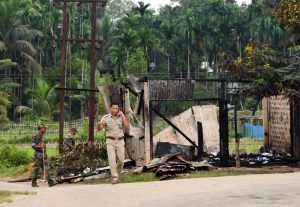Anti-Hindu violence in parts of Muslim-dominated Bangladesh over three weeks ago found an echo in the contiguous northeastern Indian state of Tripura on October 26, when a rally organized to protest the attacks on Hindus in Bangladesh turned violent.
People pelted stones and damaged the door of a mosque at Chamtilla in the North Tripura district. Police personnel were deployed in the area to bring the situation under control. Security has been tightened in vulnerable areas of the state.
The Hindu right-wing Vishwa Hindu Parishad (VHP) and the Hindu Jagran Manch had organized rallies in different parts of the state to protest against the violence in Bangladesh. The VHP denied having any role in the violent incidents.
The anti-Hindu violence in Bangladesh, which erupted during the Durga Puja festival, was triggered by rumors that the Quran had been insulted in one of the pavilions set up for the celebrations. Seven people were killed, several temples desecrated, and hundreds of houses and business establishments of the Hindu minority were torched.
Bangladesh’s Home Minister Asaduzzaman Khan said that hundreds of people had been arrested and an investigation launched into the violent incidents.
Tripura shares a long semi-porous border of 856 kilometers with Bangladesh. Muslims constitute less than 9 percent of the border state’s 4.2 million population.
The state had witnessed severe violence and was ravaged by insurgency in the 1980s and 1990s. But the violence then had more do with the conflict between the indigenous tribal communities and Bengalis. This was a period when the state was ruled by a communist government with brief intervals of Congress regimes. Muslims have not been the target of violence or hate crimes in Tripura until very recently.
In 2018, the right-wing Bharatiya Janata Party (BJP) won the assembly elections, dismantling the Left Front government that had ruled the state continuously for 25 years. The VHP and the BJP are both part of the Sangh Parivar, an umbrella grouping of Hindu organizations that espouse Hindutva.
Police officials in Tripura have said that “mischievous elements” were spreading fake news on social media about a mosque being set ablaze during the violence. According to a tweet from the police, cases had been registered and legal action would be initiated against people spreading communally sensitive rumors. The district administration has imposed restrictions on people gathering at a few sensitive areas such as Panisagar and Dharmanagar, located about 155 kilometres from the state capital Agartala.
Police protection has been provided to all mosques across the state.
Meanwhile, based on media reports, the High Court of Tripura took suo motu cognizance of the incident and has directed the state government to submit an affidavit by November 10 stating measures it has taken to ensure peace in the state.
While appreciating the government’s efforts in restoring peace and order, the high court said that more steps were necessary for restoration of normality. It has recommended the formation of peace committees not only at district levels, but also at the sub-divisional levels and, if necessary, at the villages as well.
Protests against the attack on Hindus in Bangladesh also erupted in Assam, another state in India’s northeast, in the Bengali-dominated Barak Valley, which is contiguous to Tripura. These were organized by the VHP for the “protection, safety, and security of the persecuted Hindus of Bangladesh.”
Protesters burnt the Bangladeshi national flag and called for a boycott on Bangladeshi products. They also attempted to cross the India-Bangladesh international border. They have sent a memorandum to Indian Prime Minister Narendra Modi requesting the government to stop all trade with Bangladesh.
Following the violence in Tripura, all districts in Assam have been put on alert to prevent communal disturbances.

































